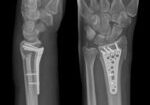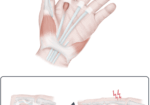Effects of Training Task on Intermanual Transfer in Upper-Limb Prosthetic Simulation
Filed under Treatments, Uncategorized
By: Emilee Saunders
Romkema, S., Bongers, R. M., van der Sluis, C. K. (2017). Influence of the type of training task on intermanual transfer effects in upper-limb prosthesis training: A randomized pre-posttest study. PLoS ONE 12(11): e0188362.
The Skinny:
The purpose of this study was to see if training a “non-affected” arm will benefit the “affected” arm during prosthetic training. The participants were adults without upper extremity amputations or other impairments, so participants used a prosthetic simulator instead of a real prosthetic for the “affected” arm. Participants were trained on specific tasks: reaching, grasping, grip-force production, and functional tasks. These tasks were trained on their opposite “non-affected” side to see if the “affected” side demonstrated improved performance afterward.

Figure 1: Prosthetic simulator: https://doi.org/10.1371/journal.pone.0188362.g002
In the Weeds:
- 71 right handed adult individuals (33 M, 38 F, mean age 22.96) without upper extremity impairments were recruited at the University of Groningen, in the Netherlands (no other demographic characteristics were given)
- All participants were randomly assigned into groups of 12 (4 training group and 2 control groups)
- Training groups: (reaching, grasping, grip- force production, and functional tasks)
- Control groups: (sham training, no training)
- Timeline
- (Day 1) All participants complete the pretest to measure the participants’ baseline skills of their “affected” arm using a prosthetic simulator.
- (Day 1-5) Training groups and the sham group practiced for five days with the OPPOSITE (training) arm (i.e., unaffected arm)
- (Day 5) All participants performed a posttest
- (Day 11) All participants perform a retention test using the simulator on the test arm.
Bringing it home:
Researchers found significant effects of the training group’s intermanual transfer of grip-force production compared to the control and sham groups, but no significant effects were found between training and sham/control groups with the other trained tasks.
Rating (0-5 rating scale):
3/5
This study shows value in that it researches ways prosthetic training can be improved by training the non affected hand. It performed statistical analyses for accurate group sizes. Researchers also carefully planned training groups so that each subtest was accurately measured without other variables interfering.
This study can be improved in the future with individuals who have upper extremity amputations and with a more diverse (and specified) demographic so that research can represent more people within the general population. Furthermore, while participants were randomized into groups, there was a lack of blinding in the study. The authors of the study also performed the training sessions, so it is possible that there was unconscious bias that might have affected the results.
Overall, this was a valuable study and one should consider intermanual transfer to train grip force production with patients who are being trained with their prosthetic.
References
Romkema, S., Bongers, R. M., van der Sluis, C. K. (2017). Figure 2: Prosthesis simulator [Photograph]. PLoS ONE.
Romkema, S., Bongers, R. M., van der Sluis, C. K. (2017). Influence of the type of training task on intermanual transfer effects in upper-limb prosthesis training: A randomized pre-posttest study. PLoS ONE 12(11): e0188362.
More To Read
Sensory Processing in People With and Without Tendinopathy
Emilee Sanders, OTS Sensory Processing in People With and Without Tendinopathy: A Systematic Review With Meta-analysis of Local, Regional, and Remote Sites in Upper- and Lower-Limb Conditions Rio, E, Sandler, J., Cheng, K., Moseley, G. L., Cook, J., & Girdwood, M. (2021) Sensory processing in people with and without tendinopathy: A systematic review with meta-analysis…
Read MoreAn evaluation of wrist and forearm range of motion during purposeful activities and exercises for distal radius fracture
An evaluation of wrist and forearm movement during purposeful activities and range of movement exercises after surgical repair of a distal radius fracture: A randomized crossover study Collis, J., Mayland, E., Wright-St Clair, V., Rashid, U., Kayes, N., & Signal, N. 2022. An evaluation of wrist and forearm movement during purposeful activities and range of…
Read MoreEDS 101: Understanding Hypermobility in the Hand Therapy Setting
EDS in the Hand Therapy Setting General Overview:Ehlers Danlos Syndrome (EDS) is a group of heritable connective tissue disorders caused bygenetic changes that affect collagen production, the protein responsible for strength and elasticityin skin, ligaments and tendons (The Ehlers Danlos Society, 2016). There are thirteen forms of EDS that each have their own set of…
Read MoreWound Healing Complications in Diabetic Patients who have undergone a Carpal Tunnel or Trigger Finger Release
By: Amalia Garcia Gundlach, B. K., Robbins, C. B., Lawton, J. N., & Lien, J. R. (2021). Wound Healing Complications in Diabetic Patients Undergoing Carpal Tunnel and Trigger Finger Releases: A Retrospective Cohort Study. The Journal of Hand Surgery, S0363502321003014. https://doi.org/10.1016/j.jhsa.2021.05.009 The Skinny – carpal tunnel and diabetes In general, individuals with diabetes are more…
Read MoreSign-up to Get Updates Straight to Your Inbox!
Sign up with us and we will send you regular blog posts on everything hand therapy, notices every time we upload new videos and tutorials, along with handout, protocols, and other useful information.






